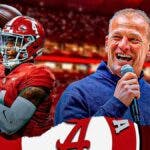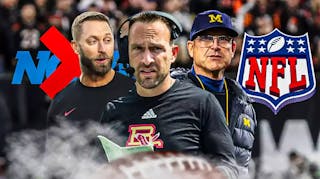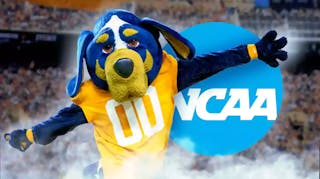The idea of college athletes earning improved and due compensation isn't some new idea. However, it still hasn't happened in the NCAA, with headway in the matter seemingly stalled.
It's high-time for that to change.
Why pay student-athletes? Aren't scholarships enough?
One of the more flimsy, common arguments against compensating student-athletes relies upon these half-hearted notions of amateurism and the “purity of the sport.” That notion somehow suggests that once someone is rightfully paid for a body of work, they immediately become corrupt, money-grubbing thieves—stealing away the luster of tomorrow's potential with today's greed.
“Isn't your scholarship enough?” they'll ask. “Isn't your opportunity at this university all you need? Why would you ever want more? Why could you ever want more?”
Rubbish notions. All of them.
https://www.tiktok.com/@highpitchedtakes/video/6940989540572105990
Student-athletes already find themselves at a disadvantage from their fellow students. Not beholden to the rigors of college athletics—which includes dietetics, individual workouts, team practices, remedial academic work and/or advanced academic affairs—the plain-ol'-run-o'-the-mill kid can immediately find themselves with a greater time advantage than their typical local college athlete.
Want to make a paid YouTube channel centered around your niche hobby? Go for it. Looking to fire up a Twitch channel and stream Hearthstone, Valorant, Destiny 2, Call of Duty, Fortnite or League of Legends? You betcha. Think you can offer up some paid tutoring in Differential Equations or Associated Press writing style? Corner that market. Hoping to make a few extra bucks delivering pizzas or waiting tables? The gateway for the college student starts there.
But not student-athletes. Don't even &*^%$#@ think about it. These are just impure thoughts, blasted into oblivion by the piety of the NCAA. So even if there was time for some side cash, it likely isn't within NCAA regulations anyway (ask former UCF kicker Donald De La Haye). Student-athletes want the benefits of image and likeness, with the little time they have. Because to be a student and an athlete at the same time isn't just a commitment: it's a crunch. The student-athlete experience, arguably, requires more clothes, more food, more mobile data and more travel flexibility than the average student, and thus, comes at a greater cost.
Even current college students recognize the grind of their sporty mates. In 2019, a poll from College Pulse found:
- A total of 38% of students said they favor, and 15% said they strongly favor, allowing universities to pay college athletes a salary, meaning that more than half (53%) of all students polled were in support of compensating college athletes.
- An estimated 51% of white students said they favor or strongly favor paying student-athletes a salary, while 52% of Hispanic students, 56% of Asian students and 61% of Black students said they favor or strongly favor paying student-athletes a salary.
- A total of 60% of those polled said that salaries should be paid to all athletes, and 38% said salaries should only be paid to athletes playing sports that bring in revenue. Women were more likely than men (65% compared to 52%) to support paying all athletes.
And though the NCAA does look like it's finally reversing some course following landmark movements with the Ed O'Bannon case and California's Fair Pay to Play Act—and we're finally getting an NCAA college football game that hopefully compensates the players we can't wait to control—the overall landscape has been bleak.
You either ball for your school at the price set for your scholarship, or else.
So, how can schools pay-for-play and everyone not lose their ever-flippin'-minds?
1: Eliminate mandatory school requirements for professional entry
In this brilliant 2018 editorial, nymag.com's Jonathan Chait opened with the idea of eliminating the NBA's “one-and-done” rule—which requires men's basketball players be at least 19 years old before entering the intrepid league.
From a maturation standpoint, the rule as it stands somewhat makes sense. Fiscal responsibility and physical development are often still in the intermediate stages of late teenagers.
But with the G-League developmental circuit as good as it's ever been, and perhaps better, the need for the world's best young basketball stars to attend college has only declined over time. Once a player reaches 18 years old, it should be up to the athlete—and the potential franchise—to assess risks and rewards before making the ultimate choice.
I'll take this a step further: end college attendance regulations for all professional sports, men's and women's.
Forcing high school graduates and prospective student-athletes to attend college for one year seems like a fool's errand, anyways. Two semesters isn't exactly some life-changing affair, particularly if the mindset at the beginning of the mission is to just “get to the pros.”
Once afforded the luxury and time, some of the world's biggest stars have eventually returned to the classroom, and that's great. That's choice. As careers dwindle, the idea of developing a trade or life skill becomes more important, and most people realize this on their own.
But not so much in the minds 18-year-olds in their physical prime.
The amount of dead money invested in one-year indentured contracts essentially removes scholarship opportunities and any other flush funds for those who may be seeking two-year, four-year or even more terminal degrees. The most recent and notable example of one-and-done being a waste on both fronts came through former LSU star and current Philadelphia 76ers stud Ben Simmons, in which he readily admitted school just “wasn't for him.”
And, you know what? It doesn't have to be.
2: Allow student-athlete unions
The NCAA has already ruled that student-athletes are not employees of their prospective universities, and thusly can't unionize for collective bargaining.
But with antitrust law at the forefront of those discussions, and the recent #NotNCAAProperty trend rising at the 2021 NCAA men's basketball tournament in Indiana, it's time for student-athletes to revisit these thoughts, if only in order to form a more perfect union.
3: Reinvest outlandish buyouts
I'm never going to fault a coach who inks a dotted line, knowing a big fat bonus is on the way if failure is the final option. Coaches, like everyone else, climb the corporate ladder and earn their way to significant paydays based on a specific skill-set. Buyouts are insurance policies against poaching, and often provide fair recompense through due (and sometimes unfair) process.
But the amount of money surrounding the songs of surrender has been staggering, particularly in the last year. As of December 2020, more than $100 million had been assigned to FBS coaching buyouts alone, and this is without the consideration of private decisions (such as Derek Mason at Vanderbilt).
Recently, Indiana relied on the “generosity” of two anonymous boosters to pay Hoosiers men's basketball coach Archie Miller $10.35 million to walk. It sounds egregious, until one realizes Miller's money line is only the Big Ten's fifth-largest currently in conference.
This rough tally brings us to a whopping $110 million and change for contract termination, and there's likely more shuffle coming in the NCAA ranks over the next few weeks.
So what happens if all the buyout bucks go into an independent fund—akin to the house-rules Community Chest/Get Out of Jail space in Monopoly—and it's annually divvied up among the 1,200-plus NCAA member schools? It might force administrations to rethink their contract structures, sure. But in the end, it could provide minimal relief for student-athletes who obviously absorb transfer costs when their coaches get fired/move on, or at the very least could help with books, meal plans, or God forbid—provide players some purchasing power.




